Bioreactor Process Development and Scale-Up for Transient Transfection-Based Lentivirus Manufacturing in Suspension Cell Culture
The challenges faced by lentivirus manufacturers can be alleviated with the development of a scalable lentivirus manufacturing platform. As there are many undesirable characteristics of traditional adherent cell culture systems, a scalable platform will need to include: a chemically defined medium, suspension-adapted cells, and bioreactor process development.
This article describes considerations for suspension-based, transient transfection bioreactor process development and scaleup of lentivirus production. We will describe the approach taken for process development which includes:
- Use of a Scale-down Model for Lentivirus Production
- Phase I and II for Early Bioreactor Process Development
- Process Parameters Tested Using Scale-down Model
- Scale-up of Lentivirus Production
- Bioreactor Process Development Phase I
- Bioreactor Process Development Phase II
- Scale-up Phase I
- Scale-up Phase II
- Materials and Methods
Use of a Scale-Down Model for Lentivirus Production
Bench-scale bioreactors (1-5L) are typically used to test multiple variables prior to moving to a larger scale, as these scale-down models are predictive of larger scale performance and are cost-effective. Through experimentation in these vessels, physicochemical process parameters are defined for scale-up. Ideally, bench-scale bioreactors are of similar geometry to the larger scale bioreactors to be used so that process engineering parameters like tip speed and power per unit volume can be kept constant. However, if the bioreactor platform is not the same, then the process parameters are altered to achieve similar performance.
Phase I and II for Early Bioreactor Process Development
Our approach for early bioreactor process development was to divide the development into two phases.
Phase I focused on growth of VirusExpress® 293T Lentiviral Production Cells. VirusExpress® 293T Lentiviral Production Cells are a clonal derivative of the HEK293T cell line1 that has been selected for faster growth, minimal clumping, higher transfection efficiency using a PEI-based transfection reagent, and higher lentivirus productivity. The cells have been suspension-adapted in a media formulation that is chemically defined, animal component-free, and optimized for PEI-based transfection (CD Prototype I).
Phase II was designed for testing of lentivirus production by the VirusExpress® 293T cells in CD Prototype I. The rationale for the division was due to the possibility of cell growth or health being adversely affected by suboptimal growth parameters which could then lead to poor lentivirus production.
The objectives of the process development activities were to define process parameters for pH, dissolved oxygen, and sparger type for gassing and agitation rate, and to understand process performance and design space. Where feasible, design of experiments (DOE) studies were run to determine the relationships between multiple factors. Throughout both phases and process development activities, scalability was kept in mind. Process engineering parameters such as agitation rate along with fluid density and volume and impeller diameter and power number were converted to power per unit volume (P/V expressed in W/m3) or energy dissipation rate. Maintaining equivalent power per unit volume across scales is one commonly used approach for bioreactor process scale-up.
Process Parameters Tested Using Scale-Down Model
Factors such as pH, agitation rate, dissolved oxygen concentration, and gas sparger options can affect cellular productivity and viral vector stability in bioreactors. pH can adversely affect HEK293T cell growth as well as lentivirus production/stability. Lentiviral vector is an enveloped virus and is known to be stable at pH 7. However, half-life decreases to less than 10 minutes at pH 6 and 82. Despite this, it has previously been reported that the production of lentivirus is inversely proportional to the pH of serum-supplemented culture medium and adjusting the pH of production medium to 6 results in higher lentivirus titers3.
Agitation impacts mixing in the bioreactor and is used to reduce or eliminate concentration gradients. Concentration gradients apply to cells, gas, cell culture medium nutrients/metabolites, temperature, and transfection. If the agitation rate is too high, shear stress can adversely affect cell growth and lentivirus production or stability. On the other hand, if the agitation rate is too low, the cells will start to aggregate, resulting in cell clumping and suboptimal growth due in part to poor gas transfer. It is important to consider that an agitation rate that is adequate for cell growth and de-clumping of cells may not be optimal for lentivirus production.
Delivering oxygen to cells is critical, as it is essential for cell growth and lentivirus production. Oxygen is delivered into the bioreactor in combination with air or in pure form through the selected sparger type. The delivery should be balanced with the cells’ oxygen uptake rate, which is cell line dependent, and the oxygen transfer rate from gas to liquid interface. Limited dissolved oxygen concentration can retard cell growth and lengthen the time to reach target cell densities for transient transfection. The mass transfer of oxygen from gas to liquid interface is defined as kLa, and many factors can influence this value. Some gas sparger configurations such as micro-sparging can increase shear stress on cells and lentiviral vector due to the generation of smaller bubbles. In order to avoid high shear stress, an open-pipe sparger configuration is often used for virus production.
Scale-Up of Lentivirus Production
When scaling-up a bioreactor process, there are many factors that could impact the control of the key process parameters for optimal cell growth and virus production. Such factors include mixing efficiency and gas transfer capability, which could have a direct impact on pH control and oxygen supply. These factors are specific to the bioreactor design and should be understood for the bioreactor platform utilized for process intensification. The scale-up development activities were performed in Mobius® Single-Use Bioreactor Platform, which includes a bench-scale 3 L bioreactor and production bioreactors ranging from 50 L to 2,000 L.
For the scale-up work described, the Mobius® 50 L Bioreactor was utilized. Studies to understand the process performance in the production scale bioreactor can be numerous, time-intensive, and incur a high cost of goods. Where bioreactor performance data may be limited, one approach to bioreactor scale-up is to maintain the same power per unit volume process value (W/m3) and linearly scale the process gases (maintaining the same volume of gas per volume of liquid per minute); this is the approach we used here.
The same two-phase approach utilized for bench-scale development was utilized for scale-up development: Phase I – optimization of cell growth and Phase II – optimization of lentivirus production with VirusExpress® 293T cells grown in chemically defined medium.
Bioreactor Process Development Phase I - Process Parameter Definition for Growth of VirusExpress® 293T Cells in CD Prototype I Medium in the Mobius® 3 L Single-Use Bioreactor
Low Agitation Rate Corresponds to Higher Cell Aggregation in the Bioreactor
With a working volume of 1.5 L, agitation rates of 95 rpm and 204 rpm (with corresponding power per unit volume of 2 W/m3 and 20 W/m3) were tested to determine optimal growth performance of VirusExpress® 293T cells in Mobius® 3 L Single-Use Bioreactors. Shaker flasks were set up as controls. In the bioreactors, the gases (air, oxygen, and carbon dioxide) were sparged through the micro-sparger, pH was set to 7.2± 0.05 deadband, and temperature was controlled at 37 °C. Peak viable cell density (VCD) of 7.0 x 106 cells/mL was achieved in the bioreactor controlled at 204 rpm (20 W/m3) on Day 4, which was very similar to the VCD obtained in the control shaker flasks at 7.4 x 106 cells/mL. However, the VCD was considerably lower at peak density of 5.0 x 106 cells/mL in the bioreactor controlled at 95 rpm (2 W/m3) which was reached a day later (Day 5). The cell health/quality was substantially compromised in the bioreactor mixed with a lower agitation rate and this corresponded to higher levels of cell aggregation. For all vessels, the viability was ≥ 85% up to day 5. Metabolites and nutrient analysis data indicated that the cells produced higher amounts of lactate (up to 3 g/L) in bioreactors compared to shaker flasks (up to 1 g/L, data not shown). However, the trend was the opposite with ammonium production, where the level reached 3 mM in shaker flasks compared to 1 mM in bioreactors (data not shown). An agitation rate of 204 rpm (20 W/m3) was determined to be optimal for growth of the VirusExpress® 293T cells in 3 L bioreactors.
pH 7.05 Selected as Bioprocess Setpoint
The pH excursion study involved testing of multiple setpoints for pH with deadband 0.05, namely pH 6.75, 6.9, 7.05, and 7.2. The lower pH setpoint was tested to understand if the cells were able to tolerate lower pH thus enabling our understanding of design space and process tolerance. We assessed cell growth performance and nutrient/metabolite profiles in all pH conditions. Peak VCD of 7–8 x 106 cells/mL was achieved in all bioreactors with the day of the peak density varying among the conditions. Peak VCD was slightly reduced in shaker flasks. Cells consumed glucose and glutamine at the highest rate when cultured at pH 7.2, followed by pH 7.05, 6.9, and 6.75. The trend was comparable with production of lactate, with highest levels produced by cells cultured at pH 7.2, followed by pH 7.05, 6.9, and finally pH 6.75. However, ammonium production was highest in cells cultured at pH 6.75, followed by pH 6.9 and 7.05, and finally pH 7.2. A pH of 7.05 was selected as the process setpoint due to the observation that base was not added to this bioreactor compared to pH 7.2 (data not shown).
50% Dissolved Oxygen & An Open-Pipe Sparger Selected for Gassing
For dissolved oxygen concentration, 30% and 50% setpoints were tested along with gassing through a micro sparger or open-pipe sparger present on the Mobius® 3 L Single-Use Bioreactor. A total of four bioreactors were set up along with control shaker flasks in duplicate. A peak VCD of 5–6 x 106 cells/mL was obtained for all bioreactor conditions and in shaker flask controls. Cells maintained viability ≥ 97% up to day 4 in all vessels. Cell growth was not affected by use of the micro sparger, which creates smaller sized bubbles and possibly contributes to higher shear. Due to the level of foam present in the bioreactors with use of the micro sparger, an open-pipe configuration was selected for gassing and to control dissolved oxygen at a 50% setpoint.
Bioreactor Process Development Phase II - Process Parameter Definition for Lentivirus Production by VirusExpress® 293T Cells in CD Prototype I Medium in the Mobius® 3 L Single-Use Bioreactor
A 256 rpm Agitation Rate Selected for Lentivirus Production
Spanning over two different bioreactor experiments, agitation rates of 150 rpm (8 W/m3), 181 rpm (14 W/m3), 204 rpm (20 W/m3), 256 rpm (40 W/m3), and 294 rpm (60 W/m3) were tested for lentivirus production. Since lentivirus is an enveloped virus and is known to be shear-sensitive, a lower agitation rate of 150 rpm was tested while the higher setpoints were included to understand process tolerance. Duplicate shaker flasks served as controls. We observed that lentivirus titer was not affected in the range tested of 8 W/m3 to 60 W/m3 (Figure 1). We decided to use a 256 rpm agitation rate (or 40 W/m3) for the lentivirus production phase as the higher rate was not detrimental to functionality of the lentiviral vector.
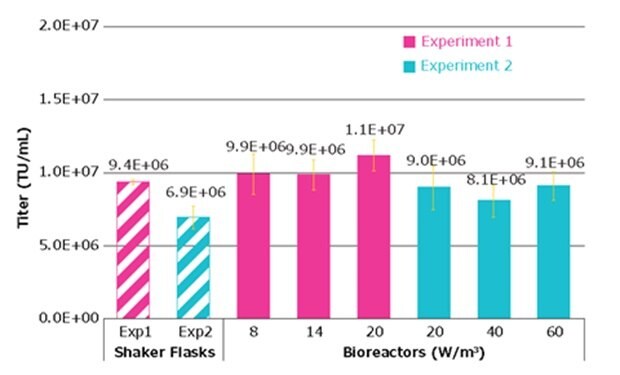
Figure 1.The effect of agitation rate on lentivirus functional titers produced by VirusExpress® 293T Lentiviral Production Cells in Mobius® 3 L Single-Use Bioreactors at 48 hours post-transfection. 125 mL shaker flasks were set up as controls. Each bar represents an average of two dilutions of lentivirus samples plated in triplicate for functional titer assay; error bars are standard deviation.
Lentivirus Production at pH 7.0-7.1 Gives the Highest Functional Titers
Similar to the cell growth performance experiment, a pH excursion study was conducted for lentivirus production. pH setpoints of 6.8, 7.0, 7.1, 7.2, and 7.4 were used throughout the 24-hour seeding/growth phase followed by lentivirus production up to 48 hours post-transfection. In contrast to previously reported observations for the pH of medium supplemented with serum3, when using our chemically defined medium formulation, we observed that VirusExpress® 293T Lentiviral Production Cells yielded the highest functional titer at pH 7.0 and 7.1, with a reduction of about 30–40% in titer with a slightly acidic setpoint of pH 6.8 and slightly basic setpoints of pH 7.2 and 7.4 (Figure 2). These data highlight the importance of conducting a pH excursion study for lentivirus production with the cells and media formulation used in any given viral vector production process.
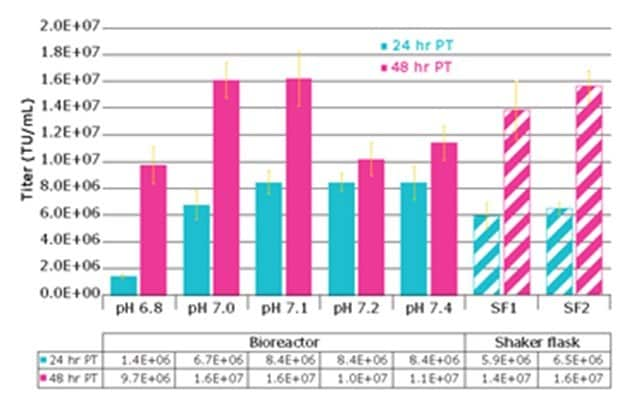
Figure 2.Lentivirus titers from pH excursion study in Mobius® 3 L Single-Use Bioreactors. PT = post-transfection. 125 mL shaker flasks were set up as control. Each bar represents an average of two dilutions of lentivirus samples plated in triplicate for functional titer assay; error bars are standard deviation.
Open-pipe Configuration Preferred for Gassing During Lentivirus Production
The same experimental setup was executed with the lentivirus production phase as that executed for the growth phase. Both 30% and 50% dissolved oxygen concentrations and gassing through an open-pipe and micro sparger were tested. An approximately 25% decrease in lentivirus titer was observed when using the micro sparger option for delivery of air and oxygen as compared to an open pipe configuration (Figure 3). The 50% dissolved oxygen and micro sparger bioreactor was lost due to contamination. Since it is well known that the smaller sized bubbles created by the micro sparger result in higher shear, we opted to proceed with an open-pipe for gassing during lentivirus production.
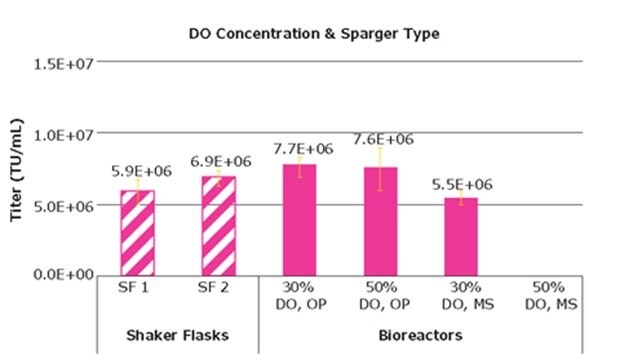
Figure 3.Lentivirus titers resulting from use of micro sparger or open-pipe for gas sparging and differing dissolved oxygen concentration in Mobius® 3 L Single-Use Bioreactors and shake flasks (SF). DO = dissolved oxygen, OP = open-pipe, MS = micro sparger.
Process parameters for both the growth phase of VirusExpress® 293T Lentiviral Production Cells and lentivirus production phase were defined through process development activities using the Mobius® 3 L Single-Use Bioreactor (Table 1). These parameters were tech-transferred for scale-up of activities in the Mobius® 50 L Bioreactor.
Scale-up Phase I – VirusExpress® 293T Cell Growth Characterization in CD Prototype I in the Mobius® 50 L Bioreactor
Unlike the bench-scale lentivirus production model, the scale-up (Mobius® 50 L Single-Use Bioreactor) lentivirus production model uses the bioreactor for cell expansion prior to the virus production phase of the process. Specifically, the Mobius® 50 L Bioreactor was the N-1 stage vessel. After achieving the N-1 stage target VCD, the culture is diluted 1:4 for the N-stage lentivirus production.
The process flow for the 50 L bioreactor production scale is as follows:
- Growth
- Day 0: Inoculate 50 L bioreactor at 10 L working volume
- Day 3: 1:4 dilution to production volume at 40 L
- Transfection
- Day 4: Transfect with plasmids and PEI
- Lentivirus Production
- Day 5: Monitor and sample
- Day 6: Harvest
Following the process flow described, characterization of VirusExpress® 293T cell growth was assessed in the Mobius® 50 L Bioreactor for both the N-1 stage (cell expansion phase) and the N-stage (virus production phase), but without transfecting the cells on Day 4 of the process. The process control parameters used were those established at the bench-scale (Table 1) with the scale-up approach previously described. Gas flow rates were adjusted accordingly to maintain demand with an increased working volume. The sparged process gases were air, oxygen, and carbon dioxide and were supplied through the open-pipe sparger. An air overlay was supplied at a constant rate equivalent to exchanging one full reactor volume in two hours. We examined cell growth and metabolite profiles of VirusExpress® 293T cells in a growth-only run in the Mobius® 50 L Bioreactor; data for 250 mL shake flasks and Mobius® 3 L Bioreactor controls were also included.
VirusExpress® 293T cells achieved a VCD of 5.5 x106 cells/mL with 98.9% viability on Day 3, 2.9 x 106 cells/mL with 98.0% viability on Day 4 (24 hours post-dilution), and a peak of 8.9x106 cells/mL with 98.2% viability on Day 6. The growth profile for both N-1 and N-stages in 50 L bioreactors was slower than that of the control vessels. A comparison of the metabolic profiles does not show significant differences between the Mobius® 50 L Bioreactor versus the control vessels. Data from shake flask studies demonstrated that the VCD at time of transfection was a key parameter for achieving the target functional titer of > 1 x 107 TU/mL; specifically, a VCD of ≥ 2.4 x 106 cells/mL. Because the transfection VCD was achieved with the process parameters utilized during the growth-only run, we continued with Phase II of the scale-up development.
Scale-up Phase II – Lentivirus Production in VirusExpress® 293T cells and CD Prototype I in the Mobius® 50 L Bioreactor
Lentivirus Production Run 1
The process flow outlined above was followed for the development of the N-1 stage (virus production phase) in the Mobius® 50 L Bioreactor. Lentivirus Production Run 1 was setup using the same bioreactor process control parameters as the growth run (Table 1). Two controls were set up during the LV production phase of the process; one shake flask utilized cells from the Mobius® 50 L Bioreactor as the inoculum and the other shake flask utilized cells from a shake flask as the inoculum. The cultures were sampled at 24 and 48 hours post-transfection for functional titer analysis from each of the production vessels. In the Mobius® 50 L Bioreactor, the cells achieved a VCD of 4.5 x 106 cells/mL with 98.8% viability pre-dilution (Day 3), and a VCD of 2.4 x 106 cells/mL with 98.9% viability at the time of transfection (Day 4). Target VCDs for the end of N-1 stage and at the time of transfection were achieved. At the 48-hour harvest time point, we observed a functional titer from a fresh analytical sample of 1.35 ± 0.06 x 107 TU/mL (Figure 4).
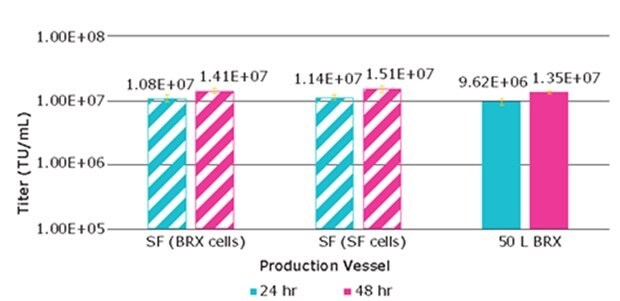
Figure 4.Lentivirus Production Run 1: functional titer of crude harvest from VirusExpress® 293T cells producing lentivirus via transient transfection in a Mobius® 50 L Bioreactor (50 L BRX) or control shake flasks (SF).
Lentivirus Production Runs 2 & 3
For the next two lentivirus production runs, a different gassing strategy was implemented. We decided to sparge gas on demand only: oxygen was sparged on demand when the DO % saturation dropped below the set point, and carbon dioxide was sparged when the process value for pH was above the set point. Lentivirus production controls in shake flasks were also performed. For Lentivirus Production Run 2, the cells achieved a pre-dilution VCD of 5.5 x 106 cells/mL with a viability of 98.4% (Figure 5a). For Lentivirus Production Run 3, a predilution VCD of 5.1 x 106 cells/mL with 99.2% viability was achieved. The VCD at time of transfection for Runs 2 and 3 were 2.5 x 106 cells/mL with 98.5% viability (Figure 5a) and 2.4 x 106 cells/mL with 98.7% viability, respectively. For both runs, the growth profile for the N-1 stage trended well with the shake flask control. We observed functional titers from the Mobius® 50 L Bioreactor in Lentivirus Production Run 2 as 1.89 ± 0.33 x 107 TU/mL (Figure 5b) and in Lentivirus Production Run 3 as 1.34 ± 0.18 x 107 TU/mL (Figure 6).
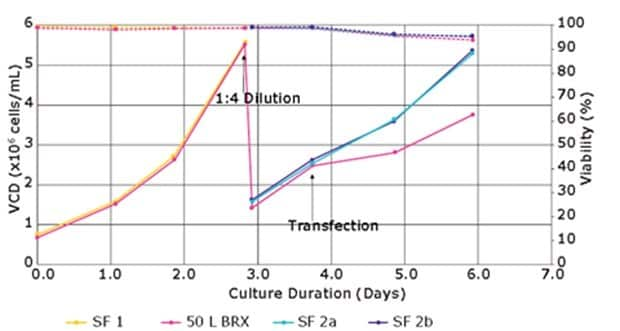
Figure 5a.Lentivirus Production Run 2: cell growth (solid lines) and viability (dashed lines) profiles for VirusExpress® 293T cells in the cell expansion and virus production phases in a 50 L bioreactor (50 L BRX) or shake flask controls (SF 1, SF 2a, SF 2b).
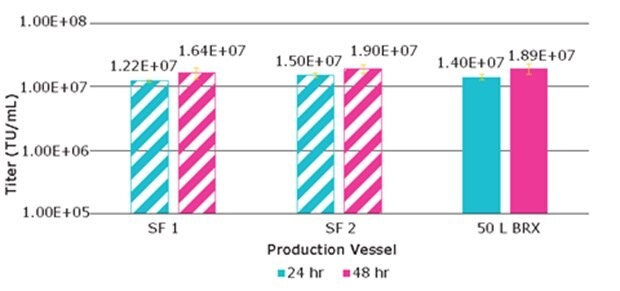
Figure 5b.Lentivirus Production Run 2: functional titer of crude harvest from VirusExpress® 293T cells producing lentivirus via transient transfection in a Mobius® 50 L Bioreactor (50 L BRX) or control shake flasks (SF 1 and SF 2).
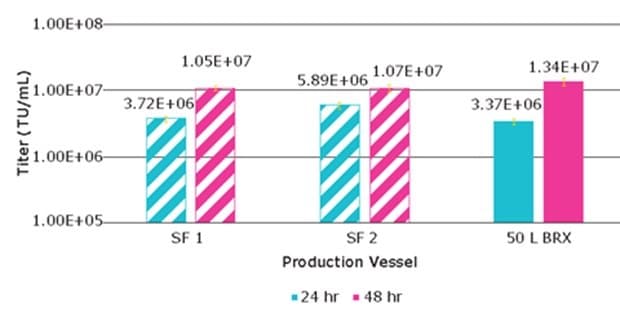
Figure 6.Lentivirus Production Run 3: functional titer of crude harvest from VirusExpress® 293T cells producing lentivirus via transient transfection in a Mobius® 50 L Bioreactor (50 L BRX) or control shake flasks (SF1 and SF2).
In summary, the three scale-up lentivirus production runs in the Mobius® 50 L Bioreactor exceeded a target functional titer of 1 x 107 TU/mL. Across all three runs, we observed a cell-specific productivity between 5 and 8 TU/cell (Figure 7).
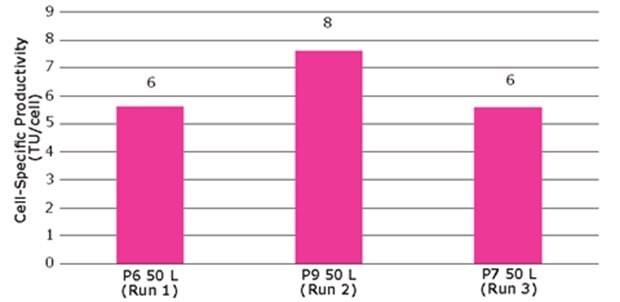
Figure 7.Specific productivity (transducing units per cell) for the three lentivirus production runs.
The VirusExpress® Lentivirus Production Platform Addresses Process Intensification Challenges for Lentivirus Manufacturing
We developed a bioreactor process using the VirusExpress® Lentiviral Production Platform and demonstrated its scalability and reproducibility in the Mobius® family of bioreactors. Our data suggest that the VirusExpress® Lentiviral Production Platform addresses the current challenges the industry faces for lentiviral production process intensification and scalability. Transgene-specific optimization could be performed in shake flask studies, then quickly moved to bioreactor production. This platform meets the need for a suspension-adapted cell line using a chemically defined medium amenable to scale-up and fit-for-purpose as a cGMP upstream platform.
Materials and Methods
Cell Counting
The Trypan Blue exclusion method was used to analyze VirusExpress® 293T cells for viable cell density (VCD) and viability using a Beckman Vi-CELL XR automated cell counter. Because HEK293 cells and their derivatives are known to aggregate, samples were treated with Accumax™ cell dissociation solution prior to cell counting. Sample treatment entailed combining an equal volume of cell culture and Accumax™ solution, mixing the solution by pipetting, and incubating at 37 °C for 30 ± 5 minutes.
Metabolite Analysis
The metabolic profile of the cell culture was analyzed using the BioProfile® FLEX2 (Nova Biomedical). No special sample preparation was required for this analysis.
Cell Expansion – Shake flask
VirusExpress® 293T Lentiviral Production Cells were thawed and maintained in complete growth media (CGM) consisting of a chemically defined media (CD Prototype I) supplemented with 6 mM L-Glutamine. For routine passaging of the cells, seeding densities were 0.6 or 0.3 x 106 cells/mL for a 3-day or 4-day passage, respectively. Cultures were maintained in a humified incubator at 37 °C, 8% CO2, and shaking at 155 rpm (19 mm orbit) or 135 rpm (25 mm orbit). Baffled shaker flasks (Corning) were used for routine passaging and virus production.
Functional Titer Analysis
To prepare the crude harvest samples for functional titer analysis, the samples were clarified via centrifugation (1000 x g, 5 minutes, room temperature). The clarified supernatant was either immediately analyzed for functional titer or stored at −80 °C for future analysis.
HT-1080 cells, a human fibrosarcoma derived cell line (ATCC CCL-121), were used for the lentivirus transduction assay to determine functional titer. HT-1080 cells were grown in MEM media + 10% fetal bovine serum in a humidified incubator at 37 °C, 5% CO2. The assay was conducted in 12-well tissue culture plates with a working volume of 1 mL for cell seeding, cell counting, and virus inoculum (test samples). 24 hours prior to transduction, HT-1080 cells were seeded at 80,000 cells per well. On the day of transduction, sample preparation entailed diluting the virus inoculum (test samples) into MEM + 10% serum with 8 μg/mL Polybrene. Approximately 24 hours post-plating, the diluted test samples were used to transduce the HT-1080 cells. Each test sample was tested at two different dilution factors and in triplicate (n=6). Approximately 48 hours post-transduction the virus-containing medium was removed, and the HT-1080 cells were washed with PBS, detached, and resuspended at a ratio of 1-part cell suspension to
2-parts 1% formaldehyde in PBS. The cells were analyzed for green fluorescent protein (GFP) expression using a Luminex Guava easyCyte flow cytometer. Only dilutions yielding 1% to 20% GFP+ cells were considered for titer calculation. The calculation for functional titer (TU/mL) was performed as follows: (% GFP+ population x viable cell density at time of transduction/volume of inoculum) x dilution factor.
Transfection for LV Production
Lentivirus production was accomplished through PEI-mediated transfection using a third-generation lentiviral system including a plasmid expressing VSV-G envelope and a transfer plasmid expressing Turbo-GFP. For the N-1 stage, VirusExpress® 293T cells were seeded at 0.6 x106 cells/mL for a 3-day passage. For the N-stage, cells from the N-1 stage were used to seed the production vessels at a target VCD of ≥ 1.2 x 106 cells/mL. Approximately 22 ± 4 hours post-seeding, when an N-stage VCD of ≥ 2.4 x 106 cells/mL was achieved, the transfection mixture was prepared. The transfection mixture consisted of equal volumes of plasmid mixture and PEI mixture and was formulated to a final volume that would maintain a ratio of 20:1, cell culture to transfection mixture volume. The plasmid mixture was prepared at a DNA concentration of ~0.44 μg/1 x 106 cells, using a molar ratio of 2.1 : 2.8 : 1 : 3.9 (pGag-pol : pREV : pEnv : pTransfer), and diluted into CGM. The PEIpro transfection reagent (Polyplus 115-100, 1 mg/mL) was diluted into CGM at a PEI:DNA mass ratio of 3:1. The PEIpro mixture was added to the plasmid mixture and incubated at room temperature for 15 minutes. During the incubation, the transfection mix was periodically mixed by swirling the solution every 2-3 minutes. At the end of the incubation, the transfection mix was added to the production vessel(s) by gravity. No media change or addition was required post-transfection and harvest was performed 48 hours post transfection.
Bench-scale Bioreactor Process Development
Cells were expanded in baffled shaker flasks (125 mL to 2 L) for seeding of the Mobius® 3 L Single-Use Bioreactors. The cell inoculum was at Passage 4 or greater from 2 L shaker flasks. A target seeding VCD of 1.2 x 106 cells/mL was used to inoculate a working volume of 1.5 L. Temperature was held constant at 37 °C and pH, dissolved oxygen, and agitation rate were varied. The sparged process gases were air, oxygen, and carbon dioxide and were supplied through either micro- or open pipe sparger. Air was also supplied through the over-lay. The transfection mix was prepared as previously described. From the day of inoculation to the day of the harvest at 48 hours post-transfection, each bioreactor was sampled for cell counts, nutrient and metabolites, and functional titer analysis.
Scale-up Development: N-1 in the Mobius® 50 L Bioreactor
All studies at 10–40 L volume were conducted in the Mobius® 50 L Single-Use Bioreactor (Single-use Stirred Tank - CR0050L102, SensorReady Loop - CRSR110A01, and Vent Filter Assembly - CRVFL05E01).
Prior to seeding the Mobius® 50 L Bioreactor for the N-1 stage, the cells were expanded in baffled shaker flasks (125 mL to 3 L). Inoculum from 3 L shaker flasks from Passage 5 or greater was used to seed the bioreactor at a target VCD of 0.6 x 106 cells/mL at a 10 L working volume. Bioreactor process parameters for the N-1 are summarized in Table 1. The culture was sampled daily for cell counts and metabolite profile. On day 3, an N-1 final VCD of > 4.5 x 106 cells/mL was achieved and a 1:4 dilution of the culture was performed using prewarmed, fresh CGM to bring the working volume to 40 L for the N-stage.
Scale-up Development N-Stage LV Production
Approximately 22 ± 4 hours post-dilution, the target VCD for transfection of ≥ 2.4 x 106 cells/mL was achieved. The transfection mix was scaled-up proportionally and prepared as previously described. The bioreactor process parameters used for the N-stage were the same for the N-1 stage (Table 1). The culture was sampled daily for cell counts, metabolite profile, and functional titer analysis. The harvest time point for the lentivirus production was 48 ± 2 hours post-transfection.
Products
For more information on our VirusExpress® 293T Lentiviral Production Platform, please visit our viral vector upstream platforms page.
References
To continue reading please sign in or create an account.
Don't Have An Account?